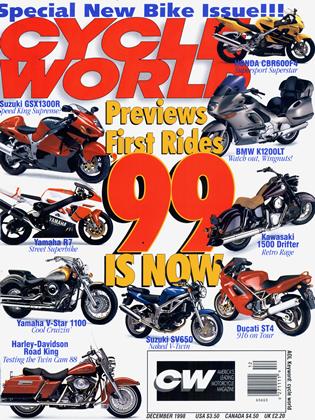Road King
Twin Cam 88: Harley's best-ever Big Twin
MATTHEW MILES
HOOPLA OR HYPE? THAT’S THE QUESTION SURROUNDing Harley-Davidson’s first all-new Big Twin motor in 62 years. We’ve already detailed the inner workings of the new Twin Cam 88 (CW, August). An impressive design, for sure, but final judgment was reserved until we could sample a “Fathead” on our home turf.
Now, having run a ’99 FLHR Road King at the dragstrip, spun its engine to redline on the dyno and traversed Southern California’s backroads and freeways, we’re convinced: This is Milwaukee’s finest.
Harley claims the carbureted Twin Cam 88 produces 8 percent more horsepower and 10 percent more torque at the rear wheel than its Evo predecessor. On a 49-state model, that should equate to an additional 4 horsepower and 7 footpounds of torque. Our testbike did even better than the brochure claims, churning out a lusty 62.5 bhp at 5250 rpm and 76.0 ft.-lbs. at 2750 rpm, a gain of 8 ponies and 8.2 ft.lbs. over the fuel-injected Road King Classic we tested earlier this year. That’s more horsepower than any other stock VTwin cruiser, whether from Japan, Italy or Minnesota. Only Kawasaki’s old-style Vulcan 1500 and Suzuki’s Intruder 1400 make more torque, 76.9 and 77.4 ft.-lbs., respectively.
And the Road King’s stablemate, the leather-bagged, fuelinjected Classic, may be even stronger. Based on past tests, H-D’s EFI is good for 3-4 more bhp and up to 5 ft.-lbs. more torque, not to mention improved cold starting and lighter throttle action. Harley also alleges slightly better in-town fuel mileage. Not bad for an extra thou. For even greater performance, Harley offers factory engine-upgrade kits. The big-bore package takes displacement out to 1550cc, and includes cylinders, pistons, gaskets, etc. When installed by an authorized dealer, the kits don’t void the bike’s warranty, either.
Even in stock form, the added oomph translates into unquestionably better acceleration, both from a standing start and during top-gear roll-ons (see accompanying chart). As for the latter, downshifts are now less critical when passing slow-moving vehicles. That’s good, because the five-speed gearbox, a carryover from the Evo, remains as clunky as ever. Otherwise, refinement is the word here. Much of the old Evo’s mechanical noise, particularly at idle, has been tempered, and the engine has a tight, well-put-together feel, even when zinged to redline. Still, there’s no forgetting this is an air-cooled, pushrod V-Twin; Harley has done a superb job of satisfying emissions and furthering performance without deleting one iota of character or historical significance.
In the case of the Road King, this was accomplished by not changing much outside of the new, more frame-filling engine. Why mess with success, right? There have, however, been a few minor updates. For ’99, the Road King-all FLs, in fact-gets an integrated rear-brake reservoir and master cylinder; the speedo has on-board diagnostics for easier troubleshooting; and the sealed taillight features an accessory-ready hookup. All else, from the cut-down seat to the single-piston brake calipers and air-adjustable rear shocks, is identical. Our only real gripe concerns the windshield. Despite blocking out the elements, the removable screen aggravates taller riders (6-foot and up) with faceshieldrattling turbulence at any speed above 50 mph.
Buffeting aside, the FLHR remains a stylish, versatile package. It’s comfortable, long-legged and, thanks to the new 88-cube powerplant, now in possession of the performance it has long deserved. Road King is the right name. □
OLD vs. NEW:
DYNA SPORT Finally, another Big Twin back in the H-D lineup that handles as well as the late, lamented FXR, dis continued half a decade ago. FXR lovers will be impressed by the bigger power and torque curves. Dual disc brakes impress, too, although with a characteristic squeak and a dip from the underdamped fork. All-day rides are easy, thanks to the new, smoother motor-the front wheel doesn't even bounce off the ground at idle anymore. Wonders do cease, however, and the unofficial "Sport Glide" moniker isn't wholly upheld by the chromed steel rims and lack luster rear suspension units. Alloys and piggyback shocks, please. Otherwise, a big thumbs-up.
 View Full Issue
View Full Issue
More From This Issue
-
 Up Front
Up FrontMagical Mystery Tour
December 1998 By David Edwards -
 Leanings
LeaningsThe Nearly Lost Art of the Kickstart
December 1998 By Peter Egan -
 TDC
TDCCombustion Confusion
December 1998 By Kevin Cameron -
 Letters
LettersLetters
December 1998 -
 Roundup
RoundupMunich '98: What's Not For Us
December 1998 By Steve Anderson -
 Roundup
RoundupEtc.
December 1998









